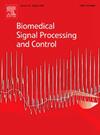基于二维多尺度符号动态熵的胸片结核检测
IF 4.9
2区 医学
Q1 ENGINEERING, BIOMEDICAL
引用次数: 0
摘要
用于筛查目的的胸部x光片(CXR)已确定了几种与肺结核(TB)相关的放射学模式。因此,为此目的出现了一些自动计算工具。我们提出了一种新的算法,二维多尺度符号动态熵(MSDE2D),以开发一种对这些细微模式变化和噪声鲁棒性敏感的计算工具,用于评估健康和结核病诊断个体的CXR图像。一维SDE算法先前被证明在检测振幅变化和计算计算方面更有效(与其他熵算法相比)。此外,我们还提取了一阶统计参数,如标准差(SD)和正像素均值(MPP)等。这些MSDE2D和一阶纹理特征分别用于检测每个肺的结核病。MSDE2D使用合成数据集进行验证,并针对最佳参数集进行了优化。我们证实,对于两个肺,健康和TB CXR图像之间的MSDE2D值存在显著差异(P<0.05),效应量为|和| >;0.23。从一阶参数来看,两组左肺只有均值、SD、熵和MPP有统计学差异(P<0.05;| | d祝辞0.22)。对于右肺,所有一级特征对TB患者有显著的区分(P<0.05;| | d祝辞0.28)。最后,我们证明了多层感知器在检测左肺和右肺结核病方面分别获得了86.4和85.2%的准确率。在本研究中,左肺和右肺的最高灵敏度分别为71.4%和81.8%。本文章由计算机程序翻译,如有差异,请以英文原文为准。
Tuberculosis detection on chest X-rays using two-dimensional multiscale symbolic dynamic entropy
Several radiological patterns associated with pulmonary tuberculosis (TB) have been identified on chest X-rays (CXR) used for screening purposes. As a result, several automatic computational tools have emerged for this purpose. We propose a new algorithm, two-dimensional multiscale symbolic dynamic entropy (MSDE), to develop a computational tool sensitive to these subtle patterns variations and noise robustness for evaluating CXR images from healthy and TB-diagnosed individuals. The one-dimensional SDE algorithm was previously shown to be more efficient in detecting amplitude variations and in computational calculations (compared to other entropy algorithms). Additionally, we also extracted first-order statistical parameters like standard deviation (SD), and mean of positive pixels (MPP), among others. These MSDE and first-order texture features were used to detect TB in each lung individually. The MSDE was validated using a synthetic dataset and optimized for the best set of parameters. We verified that, for both lungs, the MSDE values were significantly different between healthy and TB CXR images (), and the effect size was d 0.23. From the first-order parameters, only the mean, SD, entropy, and MPP were statistically different between both groups for the left lung (; d 0.22). For the right lung, all first-order features significantly differentiated TB patients (; d 0.28). Finally, we show that a multi-layer perceptron obtained 86.4 and 85.2% accuracy in detecting TB in the left and right lungs, respectively. The highest sensitivity values achieved in this study were 71.4% and 81.8% for the left and right lungs, respectively.
求助全文
通过发布文献求助,成功后即可免费获取论文全文。
去求助
来源期刊

Biomedical Signal Processing and Control
工程技术-工程:生物医学
CiteScore
9.80
自引率
13.70%
发文量
822
审稿时长
4 months
期刊介绍:
Biomedical Signal Processing and Control aims to provide a cross-disciplinary international forum for the interchange of information on research in the measurement and analysis of signals and images in clinical medicine and the biological sciences. Emphasis is placed on contributions dealing with the practical, applications-led research on the use of methods and devices in clinical diagnosis, patient monitoring and management.
Biomedical Signal Processing and Control reflects the main areas in which these methods are being used and developed at the interface of both engineering and clinical science. The scope of the journal is defined to include relevant review papers, technical notes, short communications and letters. Tutorial papers and special issues will also be published.
 求助内容:
求助内容: 应助结果提醒方式:
应助结果提醒方式:


